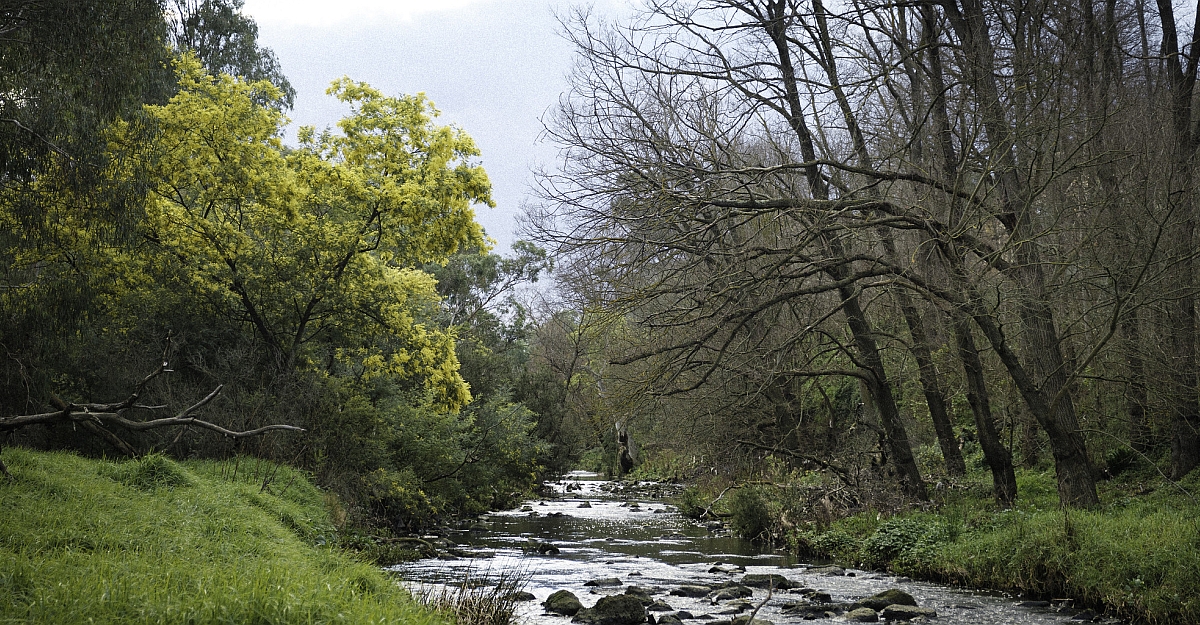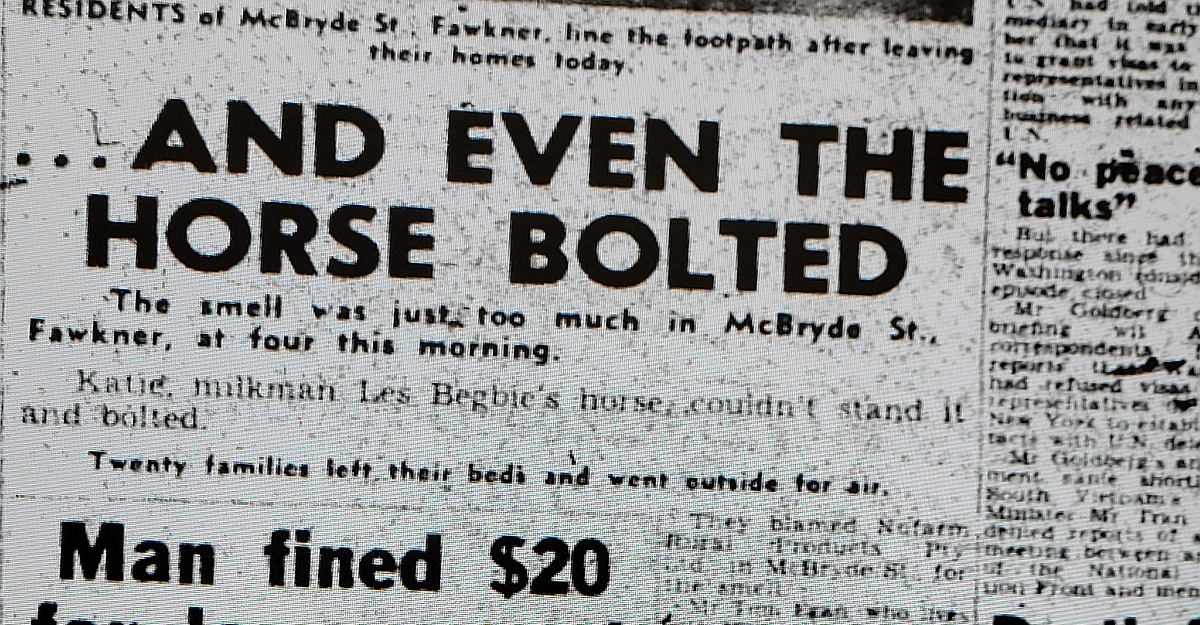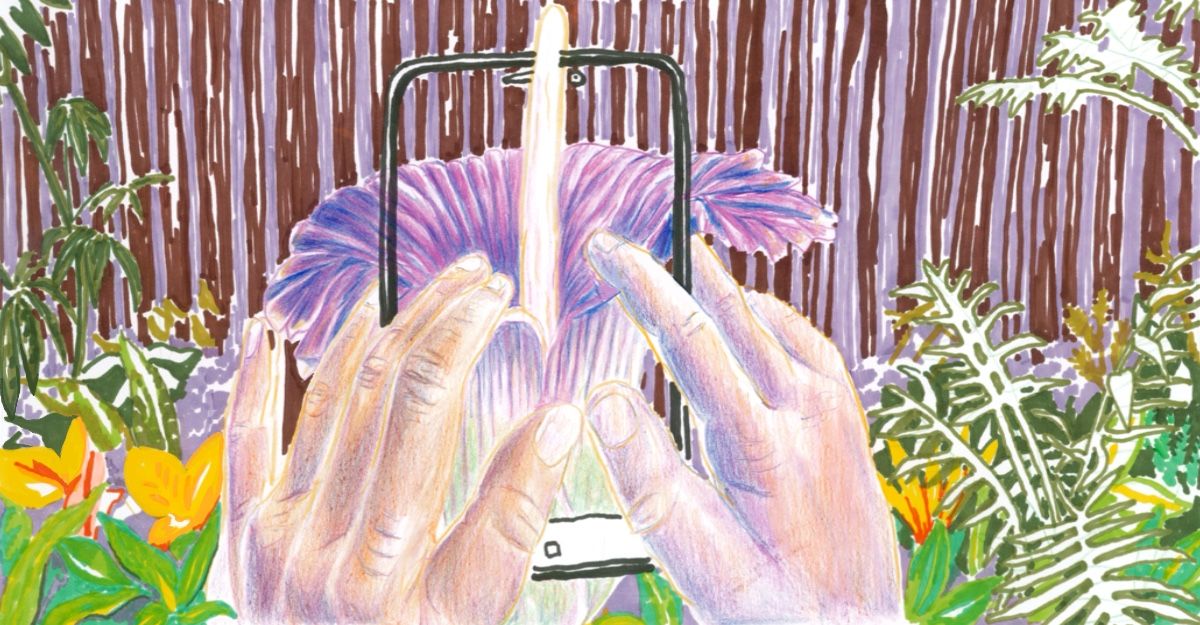Driven by the Merri-Bek City Council and local community groups such as Friends of Merri Creek, the restoration of the Merri Creek has been wildly successful. Native grasses flourish on the banks of the creek. Rainbow lorikeets perch in shady gum trees, their songs carried downstream by the northerly winds. To walk down the track is to feel like you’ve stumbled into a completely different city. One would hardly recognise this place as the runoff hub of Melbourne’s industrialised north, a deathly quiet place that stank of something unnatural just two generations ago.
Walking the trail into Fawkner, you find you’re no longer in the shade of trees or suburban fences but a rocky outcrop. Peering over it you’ll see a field of grass. Those with particularly good eyesight may see the clay piles that mark the boundary into the empty warehouse lot beyond. It’s easy to not think anything of it as you jog down the track. It is only when walking down the suburban street parallel to the path that you would feel the sense of dread. Marked on the gates, spraypaint faded over a decade of weathering, is a message:
‘DIOXIN TOXIC SITE’[1]

The pesticide industry saw an explosion following the second world war, as major powers began focusing on domestic uses for their chemical stockpiles[2]. Nufarm Rural Products was a Melbourne-originated agrochemical corporation established in 1955 and specialising in bringing these miracles of the Green Revolution into the domestic market. Fawkner saw rapid industrialisation and population growth following post-war immigration and was chosen as the location for the company’s first manufacturing plant. This was opened in 1957 across two lots of Fawkner’s McBryde St[3]. Even in these early days the factory was oddly positioned, the only thing separating it from rows of houses being a ten-metre wide road and an iron gate.
There are few universal truths in engineering, but of those that exist one is particularly worth remembering: everything leaks. Nufarm was no exception. Chemical spills were a common occurrence.
The removal mechanism for spills consisted of hosing any mess into the unsealed drains at the back of the premises. There, the pesticide run-off would be flushed into a ditch across outside of factory grounds designed to collect stormwater. This mix then was left to seep into the Merri Creek[4]. Some children refused to play by the water due to how quickly its quality deteriorated as it flowed downstream . Those who did would avoid the actual water as ‘it burned when you touched it.’[5]
Chemicals were contained in tanks below ground, as well as above[6]. These, however, were sealed improperly. Over time their actual location in the warehouse became a mystery to management and when eventually Nufarm left Fawkner, the unemptied tanks sat leeching into the soil[7].
Initially residents were told the plant was producing chemicals for hairspray. This line fell apart after work began on-site[8] and more and more grim phenomena occurred.
The lawns of nearby houses died overnight[9]. By the mid-60s the neighbourhood downwind had witnessed near-total defoliation of all but the most robust grasses[10].
Then there was the stench. Noxious odours were a frequent hazard living next to the facility, striking the neighbourhood was a constant nausea. The severity of this became apparent during a night in 1967 when a furnace being used for chemical synthesis exploded. The reported gas cloud was enough to force neighbouring families to flee into the night along with a local milk-delivery horse[11].
By 1970, the effects on the landscape and people’s health had proven enough to justify legal action. The case worked up to the supreme court case, Hicks vs Nufarm Pty Ltd.It was declared that plant’s operation should be classified as an ‘offensive or noxious trade’[12] due to the odours qualifying it as an industry of nuisance. The plant’s operational licence was rescinded and an order was issued for the factory to be shuttered[13].
Despite the order, production was still ongoing at the plant as late as 1973[14] [15]. The newly formed EPA maintained a policy of inaction on the grounds that the company’s large work force and date of establishment meant enforcing the ruling of the supreme court was a poor use of resources[16]. Nufarm would continue production for two years after being ordered to end operation, only ceasing once a new facility in Laverton was completed. The Fawkner site was sold off to a new owner to use its skeleton as a millet warehouse[17].

As far as pesticides go, Agent Orange has a stranglehold on the public consciousness[18]. Miscarriages[19], birth defects, cancers and a myriad of other long-term illnesses have been reported among those exposed to it. The picture painted by the WHO of the various ‘rainbow pesticides’ famously used in Vietnam show a compound not just toxic but ruthlessly persistent once it enters an environment.
Agent Orange is comprised of two molecular solutions mixed together: 2,4,5-T (Trichlorophenoxyacetic acid) and 2,4-D (Dichlorophenoxyacetic acid). Both are nasty on their own[20], but neither are what makes Agent Orange so deadly. The bulk of its carcinogenic and teratogenic properties stem from TCDD (2,3,7,8-tetrachlorodibenzodioxin), a trace impurity formed during 2,4,5-T synthesis. Capable of remaining intact in an ecosystem for over a decade, TCDD is known by another name: dioxin.
Partial inventories of Nufarm and later environmental assessments show that 2,4,5-T was synthesised onsite and washed into the creek[21]. Due to the notorious persistent properties of dioxin, much of that would spill out of the unsealed drains and tanks to sit in the soil for decades after the fact.
*
The pesticide-plant-turned-grain-store was abandoned after two years, the millet having become unsellable after picking up a sweet chemical smell[22]. It was passed on to a new owner to act as a general warehouse until the Eighties, when Broadmeadows Council sought to repurpose the lot for residential purposes.
While locals—who had been pressuring the council to investigate for contamination for years—disapproved, the council pushed on[23]. However, renewed attention to the site following Greenpeace actions against Nufarm’s dumping of dioxin in Laverton proved too politically poisonous: the rezoning order was dissolved and an environmental assessment from Nufarm requested.
The initial 1990 assessment concluded that there were no issues with the site. A follow-up 1991 audit found that the area from the front gates of the facility to the western bank of the Merri creek exceeded the industrial safety threshold for a dozen dangerous toxins including DDT, arsenic and dioxin. Contamination was present in both the soil and air, as well as the water table directly below. The warehouse was shuttered[24] and the EPA alerted NuFarm to their obligations to clean the site, which had been shown to have concentrations of dioxin 250 times the industrial safety threshold within the soil[25].
The proposed solution was to clean the land to regulation standards for future industrial use. Over 1993-1994, demolitionists clad in HazMat suits clambered over the warehouse[26]. The walls were hosed and vacuumed to ensure any particulate matter was out of the air before they were torn to the ground. The piles of poisonous dirt were hosed constantly to keep dry dust from spewing over Fawkner and Coburg downwind. Work was stopped when the wind was heaviest to further limit this potential spread. All contaminated soil, clay, and concrete was loaded onto trucks, then dumped unceremoniously at the Tullamarine toxic waste site.
From assessment to recovery, no party reached out to the communities of North Melbourne directly downwind of the site, nor those living around it[27].

During the Sixties, locals took notice of something more than the stink: they were getting sick. Children were born with heart and bone defects. Miscarriages among the residents started to rise. Young adults, those in their twenties, began to succumb to cancers. Respiratory problems emerged[28]. These issues were reported by multiple residents, with one of the better documented cases revolved around Elaine MacDonald, who experienced episodic inabilities to breathe following her moving to Fawkner. These symptoms worsened in 1967 (shortly before the furnace explosion), when she experienced an attack severe enough as to be pronounced momentarily dead.[29] Moving away from Fawkner, she began to recover. When forced back to Fawkner due to housing costs, she found herself struggling to breathe once more.
Despite demand from the residents for investigations into their health concerns, state and local governments refused to take notice. Fawkner residents turned to an informal survey of their neighbours to gather information as an alternative. A doorknocking campaign along McBryde St and the surrounding neighbourhood was conducted, with residents quizzed on any medical issues their families had experienced during and following operation of the plant. They alleged these results showed a cluster of cancer cases, organ failures, and congenial birth defects in the hearts and bones of children born in the area.
Residents also commented that the stench of the factory still wafted off the banks of the creek despite operations long having concluded [30], causing migraines.
The Department of Human Services was charged with assessing the human cost of the potential exposure in Fawkner. After noting the requests of residents for a formal assessment of the rates of illness surround the plant, the department recognised the potential risk but passed on any formal action, stating that:
All people who have had contact with the area since 1963 would have to be surveyed for the results to be worthy of comment.[31]
With that, all institutional discussions of the consequences of Nufarm’s activities on human beings ended until 2017, when the remediated site was sold and new works were set to begin. The episode saw renewed community interest in the site and a campaign to prevent construction for fear of disturbing the contaminants beneath the clay cap. After three years of campaigning, VCAT turned down the request to deny construction, stating that
The SoEA issued in 1995 clearly states that the land is not suitable for any potential use. It is only conditionally acceptable for ongoing industrial use.
Buried History

Walking down the Merri Creek feels like an alternate dimension. Underfoot is not sludge or runoff, but thin bristly wallaby grass. Birds sing in river gums with arms stretched over clear water. Kids splash in the water on hot days and chase the bugs and lizards that have returned. If you know what you’re looking for, you can find a steep pathway up the rocks and onto the field that was once the most toxic in Australia. You can walk along the gently sloping field of flat shin-height grass all the way to the mounds of dirt at the edge of the back fence. But this isn’t an alternate reality. This is community having to fill in for the role of the state.
From 1975, residents living on the banks of the Merri Creek began pushing back on the continuous use of the grounds as a dump site for industrial wastewater. Local groups united under the umbrella category of ‘Friends of the Merri Creek’ and took to the task of ecological restoration and beautification. After fifty years, the community that lives along the creek has managed to wrest back control of the waters from (most) industrial hands and has remedied its toxic reputation. Those you’ll speak to about it talk with passion about the creek, and you can sense the care in their voice.
You can see this care even regarding the McBryde lot. Talking with residents in the Toxic Free Fawkner community group, they note they don’t want the land to remain bare. They just believe that continuing to allow industrial interests on the land threatens to expose them yet again for the sake of capital. Before VCAT struck them down, they had planned to turn the lot into a park along the banks[32].
But there’s still something wrong here.
Peeking out from the alleyway beside, you can pass a sign declaring any individual caught dumping hard rubbish will be fined $9,000. And across from the locked gates that act as the single memorial to the plant, you’ll see a house across the road. There are many of them, all within one hundred metres of the former open toxic pit. Community is a powerful force, but it cannot alone solve the type of pollution catastrophe that has seen entire towns dissolved overnight. Eventually the state utilised its resources, but with the considerable delays and neglect of the disaster from a health perspective, it’s clear that there has been a failure to address the elements of disaster, only the removal of the aesthetics of such a thing.
You can’t tell the human cost if you don’t record it, or it will only exist in the minds of the hundred so residents of a street of a suburb on the road to Sydney. Institutions had reason to be concerned about the effects of pesticide pollution on human health, but handwaved this away as unrealistic expectations rather than a key foundation to environmental justice.
Fawkner’s toxic past ages into oblivion. The single memorial gate will be torn down as construction starts, and the locals who know will be priced out of town as gentrification expands Northward. All that will remain is the sludge one metre below the earth, and the gnawing sense of injustice stemming from the fact that those who were exposed will never know what happened to their bodies.
[1] Images on Google Street View over the period 2007 – 2021 reveal that the graffiti has been there since before 2007 and remains in place as of March 2021. Photographs taken by author as of July 2021 also show this landmark’s existence in more recent years.
[2] Tyrone Hayes, Martin Hansen, ‘From Silent Spring to Silent Night: Agrochemicals and the Anthropocene’, Elementa: Science of the Anthropocene, September 2017
[3] Edge Group, Limited Phase I and Phase II Environmental Site Assessment – 102 McBryde St, Fawkner VIC 3060, December 2015, p. 9
[4] Axis Environmental Consultants, Environmental Audit Report 100 – 102 McBryde St, Fawkner, May 1995, p. 2
[5] Joel Deane, ‘The Suburb that Fights to Breathe’, The Sunday Sun, 3 June 1990
[6] Environmental Audit Report 100 – 102, p. 3
[7] ‘The Suburb that Fights to Breathe’
[8] Ibid.
[9] ‘…And Even The Horse Bolted’, The Herald, 8 December 1967.
[10] ‘The Suburb that Fights to Breathe’
[11] ‘…And Even The Horse Bolted’
[12] Ibid.
[13] Ibid.
[14] Greenpeace, Nufarm: A Greenpeace Report, June 1991, p. 23 – 24
[15] ‘The Suburb that Fights to Breathe’
[16] Nufarm: A Greenpeace Report, p. 23 – 24
[17] MD Sidell, Fawkner Site Assessment, Direct Interaction Remediation Technology (D.I.R.T.), November 1990, p. 3 – 4
[18] David A Butler, Connections: The Early History of Scientific and Medical Research on ‘Agent Orange’, Journal of Law and Policy, 2005, Vol. 13, Iss. 2,
[19] Sacha A Krieg MD, Lora K Shahine MD, Ruth B Lathi MD, Environmental Exposure to Endocrine-Disrupting Chemicals and Miscarriage, Fertility and Sterility June 2016, Vol 106, Iss. 4, p. 941 – 947
[20] S Karanth, April 2014, Chlorophenoxy Herbicides, Encyclopedia of Toxicology (Third Edition), p. 900 – 902
[21] Environmental Audit Report 100 – 102 McBryde St, Fawkner, p. 2
[22] Fawkner Site Assessment, p. 4
[23] Ibid.
[24] Ibid.
[25] ‘The suburb that fights to breathe’
[26] MD Sindell, Demolition and Clean-Up of the Former Nufarm Site at McBryde Street, Direct Interaction Remediation Technology (D.I.R.T.), May 1995
[27] From discussion with Merri-Bek councillor Sue Bolton, 2021.
[28] ‘The suburb that fights to breathe’
[29] Joel Deane, ‘Families Blown an Ill Wind’, The Sunday Sun, 3 June 1990
[30] ‘The suburb that fights to breathe’
[31] Julia Limb, ‘Cancer Link to Toxic Site: Study’, The Sun, 3 July 1990
[32] Sofia Chapman, Toxic Free Fawkner Questions, 2021

This piece is sponsored by CoPower, Australia’s first non-profit energy co-operative. To find out more about CoPower’s mission, services, and impact funding, jump online at https://www.cooperativepower.org.au/ or call 03 9068 6036 today.






